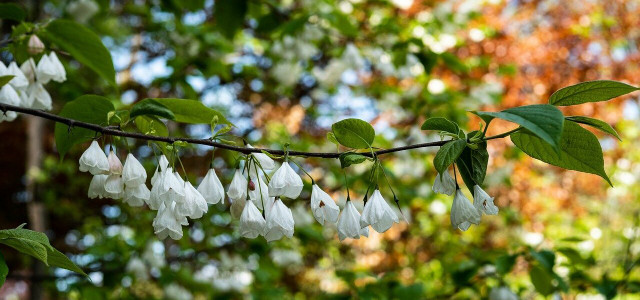The Carolina silverbell is a tree or shrub that loves moist, mineral-rich soil, and thrives in the mountains. Learn all about this beautiful bell-flowered deciduous tree here.
Halesia tetraptera (H. carolina) of the Storax Family (Styracaceae), commonly known as the Carolina silverbell, is named for the bell shape formed by its white, downward-facing flower petals.
A native of North Carolina, the Carolina silverbell is found throughout the South of the United States. Because of its beauty, size and the quality of its wood, it’s a favorite among natural landscapers, gardeners and carpenters.
Characteristics of the Carolina Silverbell

(Foto: CC0 / Pixabay / adrimarie)
The Carolina silverbell is identified as either a large shrub or a small tree.
Its mature height is around 25 to 25 feet. Horizontally, it grows around 20 to 30 feet.
If trained to grow for commercial use, it can reach a max height of 80 feet and a trunk diameter of 2 feet. In nature, it makes its way as an understory tree, twisting and turning its trunk to find its sweet spot under partially shaded sun.
Moist, loamy (fertile), and slightly acidic soil that is rich in minerals is the Carolina silverbell’s ideal ground. A deciduous tree (a plant that sheds its leaves annually), it blooms between March and April. Its flower consists of four pendulous (hanging) petals that surround its golden anthers (the pollen producing part of the stamen).
Where Does the Carolina Silverbell Grow?



(Foto: CC0 / Pixabay / dcschaef)
Native to North Carolina, the Carolina silverbell is spread throughout the South and is found most in the Appalachian Mountain range, where it is also known as the mountain silverbell. Other names remarking its physical character include snowdrop-tree and opossum-wood.
It has a life expectancy of around 100 years and will start to bloom after 3 years. It does well is in USDA zones 4 to 8 because of the region’s moderate temperature and consistent humidity. (USDA Zones are plant hardiness zones standardized by the United States Department of Agriculture).
Uses of Carolina Silverbell: A Favorite of Craftsman, Squirrels, and Bees



(Foto: CC0 / Pixabay / Graham-H)
The Carolina silverbell has a soft and fine wood that is favored by carpenters and craftsmen. Its wood goes by the names boxelder, tissood and bellwood.
The Carolina silverbell is a popular landscaping choice as it can be trained to grow short or tall depending on its surroundings. Its white flowers and green leaves branch out wide into pretty, privacy-creating walls.
The seeds of the Carolina silverbell are often eaten by squirrels and its sweet pollen is removed by bees.
Growing Carolina Silverbell



(Foto: CC0 / Pixabay / Katya_Ershova)
As a winter hardy deciduous plant, the Carolina silverbell should be seeded in your garden in the spring. Because its seeds take a long time to germinate, nurseries will often sell the Carolina silverbell as a container-grown specimen.
Its ground should be kept moist. An irrigation system could be helpful if you live in a dry environment prone to drought. A soil pH of 5 to 6 is ideal. It grows best among a collection of trees, so its spot under the sun should be partially shaded.
You should see flowers appear around April to May. With no serious pest or disease problems, you should have no problems cultivating your Carolina silverbell.
Read on:
- 11 Flowers for Bees: Turn Your Garden or Balcony Into a Bee Paradise
- How to Propagate Monstera Plants in 5 Simple Steps
- Water Propagation for Beginners: A Step by Step Guide
Do you like this post?






